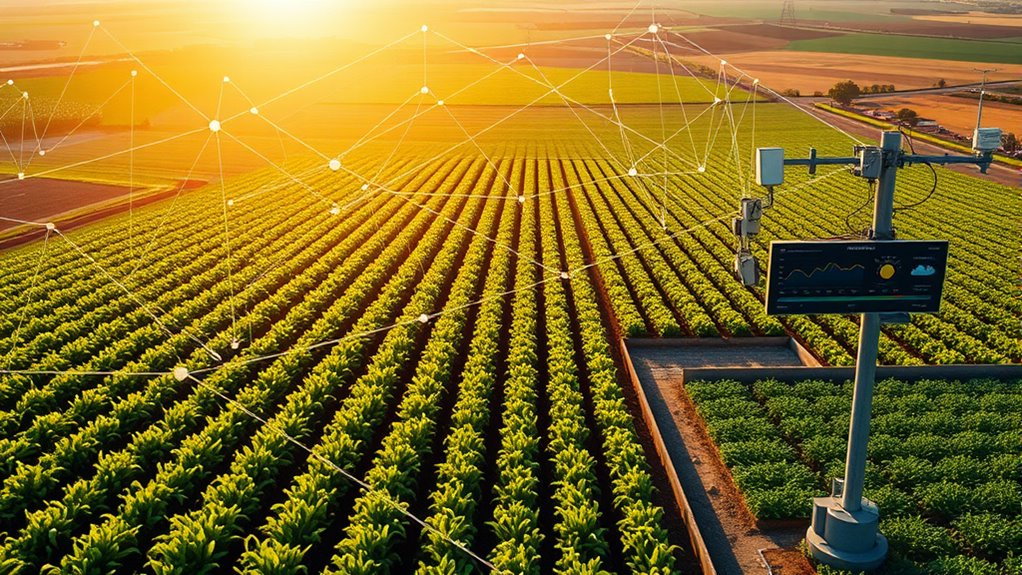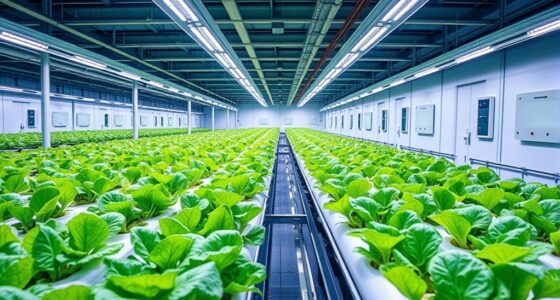Predictive models for yield and climate help you forecast crop performance under changing environmental conditions by analyzing data on weather, soil, and management practices. They allow you to simulate different scenarios, identify *best* planting and resource strategies, and prepare for extreme weather events. Using advanced analysis, these models support smarter decisions to boost productivity and sustainability. Stick around to discover how these tools can transform your approach to agriculture and climate adaptation.
Key Takeaways
- Predictive models forecast crop yields based on climate variables, helping optimize management practices and resource allocation.
- They integrate weather and soil data to simulate crop growth under various climate scenarios.
- Climate forecasts enable proactive decisions to mitigate risks like droughts or floods affecting yields.
- Machine learning enhances model accuracy by analyzing real-time environmental data for better predictions.
- These models support policymakers and researchers in developing resilient agricultural strategies amid climate change.

Predictive models for yield and climate are transforming how farmers, researchers, and policymakers prepare for future environmental changes. These models harness advanced data analysis techniques to anticipate how crops will respond to varying climate conditions. One of the key tools in this process is crop simulation, which allows you to create detailed virtual representations of crop growth under different scenarios. By inputting data about soil, weather, and management practices, you can predict how crops might perform in upcoming seasons. This enables you to identify the most suitable planting dates, irrigation schedules, and fertilizer applications, ultimately improving productivity and resource efficiency. Climate forecasting complements crop simulation by providing short-term and long-term climate predictions. These forecasts help you anticipate extreme weather events, such as droughts or floods, that could jeopardize harvests. When integrated with crop simulation models, climate forecasts give you a more all-encompassing picture of potential risks and opportunities. For instance, if climate forecasting indicates an upcoming dry spell, you can adjust your irrigation plan proactively, minimizing stress on your crops. Conversely, if heavy rainfall is expected, you can implement drainage strategies or choose more resilient crop varieties. The combination of crop simulation and climate forecasting supports adaptive decision-making, allowing you to respond swiftly to changing conditions. This foresight is especially critical as climate variability increases due to global warming. You can also use these models to explore different management practices and their impacts under future climate scenarios, helping you make well-informed choices that boost yields while reducing environmental footprints. Additionally, policymakers leverage these models to design better agricultural policies and support programs. By understanding potential future outcomes, they can allocate resources more effectively and develop strategies to mitigate climate-related risks. Researchers, on the other hand, use these models to test hypotheses about crop resilience and climate adaptation, accelerating innovation in sustainable agriculture. As technology advances, the integration of real-time weather data and machine learning algorithms further enhances the accuracy of crop simulation and climate forecasting. This means you’ll have access to more dependable predictions that can guide your daily operations and long-term planning. Furthermore, incorporating Bitcoin IRA strategies can provide farmers with innovative ways to diversify their income streams and secure financial stability amidst climate uncertainties. This means you’ll have access to more dependable predictions that can guide your daily operations and long-term planning. Ultimately, these predictive models empower you to make smarter, data-driven decisions. They turn complex environmental data into actionable insights, helping you optimize yields, conserve resources, and adapt to an unpredictable climate. By embracing crop simulation and climate forecasting, you’re better equipped to face future challenges and seize new opportunities in agriculture.
Frequently Asked Questions
How Do Predictive Models Adapt to Climate Change?
You can enhance predictive models to adapt to climate change by integrating real-time climate data and focusing on climate resilience. This allows the models to update and improve their accuracy over time. Using adaptive strategies, you can modify farming practices based on model insights, helping you better prepare for changing conditions. Continuous learning and incorporating diverse data sources guarantee your models stay relevant and effective amidst climate variability.
What Are the Limitations of Current Predictive Algorithms?
Like a boat struggling against rough seas, current predictive algorithms often face limitations due to algorithm biases and data scarcity. You might find them less accurate when climate patterns shift unexpectedly or when data is incomplete. These biases can skew results, and limited data hampers learning. As a result, predictions can be unreliable, especially in novel situations, making it essential to improve data collection and address biases for better climate and yield forecasts.
How Accurate Are These Models Across Different Regions?
You’ll find that the accuracy of these models varies markedly across regions due to regional variability. When models are well-calibrated for specific areas, they tend to perform better, capturing local climate and soil conditions. However, without proper calibration, their predictions can be less reliable, especially in regions with unique environmental factors. So, continuous calibration and accounting for regional differences are essential for improving their accuracy worldwide.
What Data Sources Are Most Reliable for Climate Prediction?
You should rely on satellite imagery and historical records for the most reliable climate predictions. Satellite imagery provides real-time, high-resolution data on weather patterns and environmental changes, while historical records give essential long-term trends. Combining these sources helps improve accuracy, enabling you to analyze past climate variability and current conditions effectively. This integrated approach offers a robust foundation for making informed climate predictions across different regions.
How Can Farmers Implement Model Insights Effectively?
To implement model insights effectively, you should focus on farmer training and technology adoption. Embrace new tools that interpret climate and yield predictions, and participate in workshops or extension programs to understand their application. By staying informed about the latest advancements and integrating these insights into your daily practices, you can make better decisions, optimize yields, and adapt to changing climate conditions more efficiently.
Conclusion
By now, you see how predictive models can transform farming and climate management. They help you stay ahead of changing conditions, making smarter decisions and avoiding surprises. Remember, knowledge is power, and these tools put it right in your hands. Embracing them means you’re not just reacting to the weather or crop yields—you’re guiding them. Don’t let opportunities slip through your fingers; seize the moment and grow with confidence.










